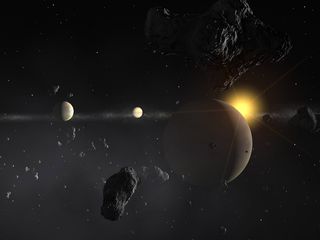
An orange dwarf star named Gliese 710 is powering in our direction and an astronomer has calculated an 86 percent chance of the interstellar interloper smashing through the Oort Cloud, located in the outermost reaches of our solar system.
This could have the devastating effect of scattering the icy Oort Cloud objects (or OCOs), causing them to plunge toward the sun and the inner planets, potentially bombarding Earth with comets.
Vadim Bobylev of the Pulkovo Astronomical Observatory in St Petersburg has published revised calculations of local star positions and velocities to arrive at this prediction.
In 1997, the European Space Agency's Hipparcos spacecraft analyzed data from 100,000 stars, compiling what is known as the Hipparcos Catalogue. 156 of these local stars are of particular interest to astronomers as the sun was thought to be a lot closer to them in the past and there is a high possibility they will make a close approach again.
In a paper submitted to the arXiv preprint service, Bobylev has combined the catalogue data with new star databases and discovered nine new stars that will buzz past the sun in the future or have done so in the past.
But one star has raised a red flag. Gliese 710 is out there and it wants to "play chicken" with our sun. Unfortunately, neither star will be able to steer out of the way at last minute.
Judging by its trajectory, there's an 86 percent chance the star will punch through the Oort Cloud (thought to be located about 50,000 AU -- or nearly a light-year -- from the sun). This may sound like a flesh wound, a near miss in cosmological distances, but any gravitational interaction with the huge chunks of cometary nuclei in the outermost extent of the solar system is bad news.
It is hypothesized that close encounters of the stellar kind have kicked OCOs out of the Oort Cloud in the past, creating some of the long period comets we see today, such as comet Hale Bopp. It is also thought that such encounters could periodically cause mass extinction events on Earth through comet impacts.
Although the star -- currently located 63 light years from Earth and approximately half the mass of our sun -- has been known to be heading for us for some time, this is the first time such a high probability for a close encounter has been calculated.
But could Gliese 710 penetrate even deeper into the solar system? Possibly, although those odds are more cheery. The chances of the star reaching as deep as the Kuiper Belt (near the orbit of Pluto) is around 1 in 1000.
This might not be an imminent threat, and it's debatable whether any human descendants will be watching the cosmic flyby, it's nice to know when the next risk of comet bombardment may occur. Although I doubt we'd be able to do much about it anyway.



It's good that Oort cloud objects are coming back to the mainstream news.